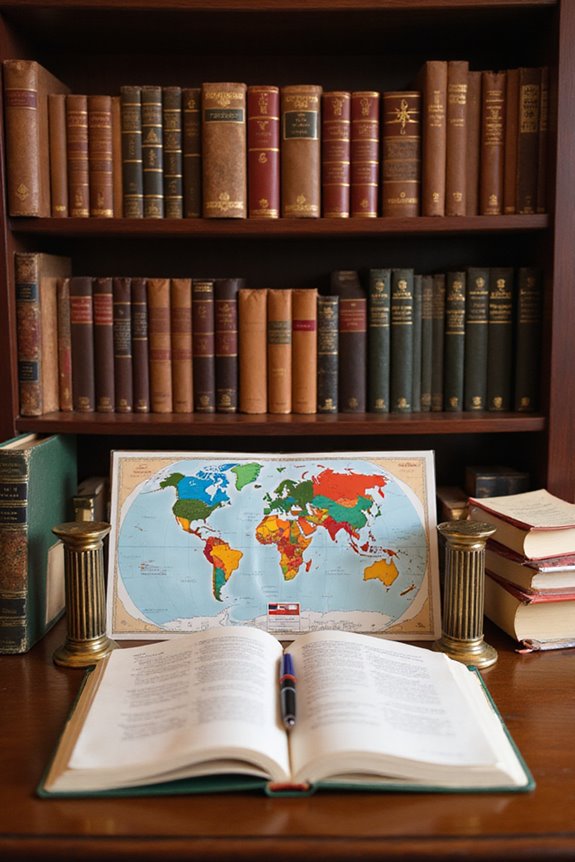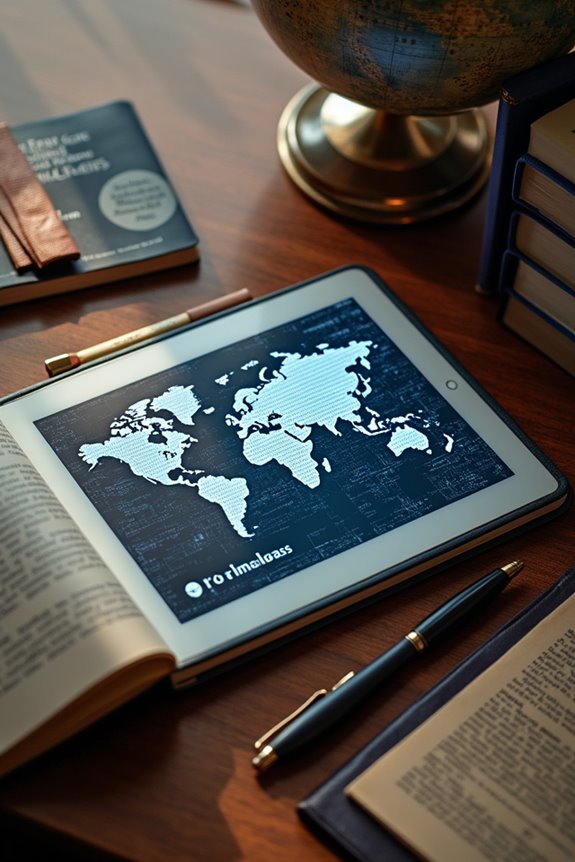Books on global political movements explore critical themes relevant today. Here are key areas often covered:
- Populism’s Rise: Examination of how populist leaders exploit societal divisions between “the people” and “the elite.”
- Economic Inequality: Discussion on how economic grievances drive political disenfranchisement and support for populism.
- Case Studies: Analysis of political disruption in regions like Venezuela and Kenya.
These texts provide insights into the changing dynamics of governance and public sentiment, leading to further understanding of future trends.
Key Takeaways
- Explore titles that analyze the rise of populism and its effects on global political landscapes, offering insights into contemporary movements.
- Look for books focusing on economic inequality’s role in fueling political unrest and supporting populist leaders.
- Consider works that examine case studies of political disruption across different regions, highlighting specific movements and their impacts.
- Investigate texts discussing the intersection of technology and geopolitical rivalries, emphasizing how they shape modern political movements.
- Seek out literature predicting future trends in global politics, particularly regarding the challenges posed by populism and rising multipolarity.
Understanding Populism and Its Global Impact
Understanding populism is essential in grasping its global impact on contemporary politics. This political phenomenon frames society as a conflict between “the people” and “the elite.” Populist rhetoric often portrays elites as corrupt and disconnected from ordinary citizens.
Key characteristics of populism include:
- Charismatic Leaders: They often claim to represent the marginalized.
- Polarizing Language: The narrative creates an “us vs. them” mentality.
- Global Resistance: Populism has surged worldwide, influencing diverse political landscapes.
Since the 1990s, populism has reshaped policies on immigration and trade, especially during economic crises. Populism has increased while some advocate democratic reforms, others may lean authoritarian, undermining democratic norms. Understanding these dynamics helps us navigate the complexities of modern political movements. For instance, the rise of humor in political communication has played a significant role in shaping public perception and engagement with populist leaders.
The Role of Economic Inequality in Political Movements

Economic inequality plays an essential role in shaping political movements, especially as citizens grapple with feelings of disenfranchisement.
- Economic grievances often arise from perceptions of unfair wealth distribution, leading to political mobilization among affected populations. Institutional impacts on economic policies can exacerbate these grievances, making them more pronounced among marginalized groups.
- Increased inequality correlates with lower voter turnout, particularly among lower-income groups, deepening political disparities.
- This disenfranchisement can foster support for populist leaders who exploit economic frustrations, further undermining democratic norms.
- Political polarization is exacerbated by economic divides, as opposing parties become viewed as antagonists rather than collaborators.
- Furthermore, the cyclical nature of economic and political inequality creates feedback loops, reinforcing existing disparities and limiting equitable policy changes. High inequality increases the risk of electing norm-shredding leaders, which is crucial for understanding these dynamics.
Understanding these dynamics is vital for comprehending the rise and impact of modern political movements.
Case Studies of Political Disruption in Different Regions

Political movements around the world often arise in response to a variety of grievances, reflecting underlying tensions within societies.
- Bangladesh Protests: Student-led protests against corruption led to a national movement, resulting in the ousting of Sheikh Hasina’s government.
- Venezuela Elections: Large-scale protests demanded fair vote counts amidst Nicolás Maduro’s authoritarian rule, highlighting electoral conflict and social unrest.
- Kenya Demonstrations: Widespread protests focused on economic inequality and transparency, showcasing public frustration with stagnant reforms and governance failures. The rise of authoritarian leaders across various regions has further fueled public discontent and mobilization efforts.
- Syria Shift: The fall of Bashar al-Assad’s regime created a fragile political landscape, marked by continued violence and external intervention.
These case studies illustrate how political disruption, driven by diverse grievances, shapes governance and civic engagement across regions.
The Intersection of Technology and Geopolitical Rivalries

As global tensions rise, technology increasingly plays a pivotal role in shaping geopolitical rivalries.
- Technological Hegemony: Nations compete fiercely for dominance, particularly in AI, semiconductors, and green energy technologies. This competition influences global power structures. Furthermore, data centres are becoming central to this struggle as they handle the vast majority of global internet traffic. Understanding the impact of globalization is vital as it exacerbates the competition among nations.
- Cyber Diplomacy: Countries engage in complex negotiations to address cyber threats and establish norms in digital warfare.
- Strategic Rivalry: Export controls and trade barriers exemplify the tactics used by major powers like the U.S. and China to maintain technological supremacy.
- Infrastructure Assets: Control over digital infrastructure and data flow has become essential, intertwining commercial interests with geopolitical strategy.
- Emerging Alliances: Global forums are adapting to these technological disputes, highlighting the evolving nature of international relations.
Together, these factors illustrate how technology shapes the landscape of global political movements.
Future Trends in Global Political Landscapes

While we navigate the complexities of the global political landscape, several key trends are emerging that will shape international relations in the coming years.
- Political Polarization: We’re witnessing heightened political polarization, especially regarding social issues, which complicates governance and policy formulation.
- Governance Challenges: Countries are grappling with significant governance challenges as populist movements rise, often prioritizing nationalism over collaborative international strategies.
- Multipolarity: Power is shifting towards a multipolar world, with emerging economies like China and India challenging traditional Western dominance.
- Diplomatic Limitations: International diplomacy faces hurdles, with conflicts showing few signs of resolution, particularly in regions like Ukraine and Syria. Additionally, the rise of populist movements reflects a shift in public sentiment towards governance, highlighting the complexities of contemporary political ideologies.
Understanding these trends will help us anticipate future political dynamics and their implications on global stability.
Frequently Asked Questions
What Are the Historical Roots of Contemporary Populist Movements?
In exploring contemporary populist movements, we see their historical roots in agrarian discontent and leftist ideology. Understanding this historical context helps us grasp how past struggles shape today’s populist rhetoric and mobilization strategies.
How Do Cultural Factors Influence Political Movements Globally?
Cultural identity shapes grassroots movements globally, driving communities to unite around shared values. By recognizing our diverse backgrounds, we can foster political engagement, challenge injustices, and promote social change that resonates with our collective experiences.
What Role Do Social Media Play in Mobilizing Political Protests?
Think of social media as a spark igniting a wildfire. It fuels political mobilization, helping us coordinate protests and spread messages instantly, connecting us across boundaries and amplifying our voices in ways traditional media can’t.
Are There Successful Examples of Reform After Political Disruptions?
We’ve seen successful reform outcomes after political disruptions, showcasing political resilience. Measures like increased transparency and independence foster trust, proving that even amid chaos, meaningful change is possible for better governance and societal trust.
How Do International Organizations Respond to Rising Populism?
While we’re all for international diplomacy, it’s ironic how a populist backlash complicates things. International organizations often navigate this tension by fostering dialogue, building coalitions, and reforming practices to engage skeptics and counteract divisions.




